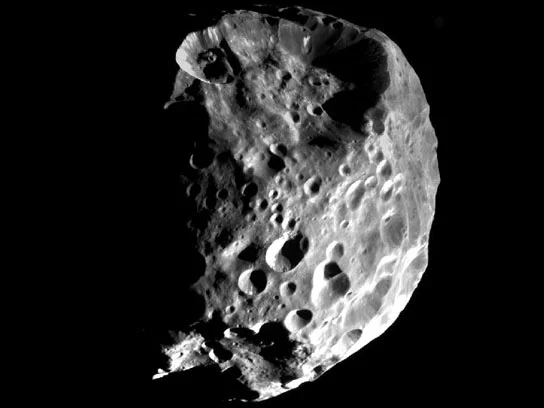Phoebe, one of Saturn’s most peculiar and unique moons, has attracted the attention of scientists due to its surprising features and cosmic elements. Phoebe is not just an ordinary moon; it also possesses planet-like characteristics, leading experts to believe it could be a “remnant” left over from the process of planet formation in the solar system.
Phoebe was first discovered in 1898 by astronomer William Henry Pickering. However, more in-depth studies of this moon only began after NASA launched the Cassini spacecraft to Saturn. Data from the Cassini mission provided scientists with valuable insights into this moon. Through the photographs and data collected, researchers identified that Phoebe has an almost spherical shape, a feature not typically seen in most moons. Phoebe is located 13 million km away from Saturn, and it follows a retrograde orbit, which raises intriguing questions about its formation and journey.

One of the most notable features is the resemblance between Phoebe and planets. “Phoebe seems to have undergone a long developmental process before it stopped,” Julie Castillo-Rogez, a planetary scientist at NASA, stated in a report published in the Planetary Science Journal, 2012. Like the planets in the solar system, Phoebe formed from materials like rock and water, but it also has distinctly different characteristics. Analyses suggest that Phoebe has a high density, with a core rich in solid rocky materials, implying that it has evolved and developed through stages, similar to planets during their formation.
Research results from the Cassini mission, published by NASA’s Jet Propulsion Laboratory in 2012, show that Phoebe may have once existed in a warm climate and environment, with the potential to harbor liquid water on its surface. This raises the hypothesis that Phoebe may have once had conditions favorable for life. Another significant discovery was the presence of water-rich material on Phoebe’s surface, further supporting the theory that this moon may have once had conditions suitable for life, even on a microscopic scale.
“Phoebe, with its strange and planet-like characteristics, could offer insights into the early formation processes in the solar system, helping us better understand the evolution of moons and planets.”
NASA, Cassini Mission, 2012.
Although Phoebe is currently a cold and distant satellite, these discoveries continue to raise open questions about the formation of planetary systems. Phoebe, with its planet-like characteristics and intriguing features, offers a new perspective on the history of the solar system and could help scientists better understand the process of planet and moon formation. These findings also reinforce the theory that planets formed from “debris” left over from the initial big bang.
We can view Phoebe as a “living relic” from the early days of the solar system, carrying stories of planet formation and, above all, serving as a key to unlocking the mysteries of the universe. These discoveries serve as a powerful reminder of the importance of continued space exploration and humanity’s endless curiosity in exploring the farthest reaches of the cosmos.
Scientists continue to study and explore strange phenomena like Phoebe, hoping to provide new answers about the formation of planets and moons in the universe, while also opening up new opportunities for future space exploration.


HPX24h > Space > Exploring Saturn’s Moon Phoebe: Planet-Like Features and Characteristics
Top Reads from This Category
Space
The Youngest Recorded Supernova: Unveiling the Mystery of a Star’s Death
Space
Tidal Heating: A New Challenge for Extraterrestrial Life
Space
Scientists Believe Water Ice Could Exist on the Giant Asteroid Vesta
Space
Three Earth-Like Planets That Could Support Life: New Discovery from NASA
Space
Gamma Ray Bursts and the Key to the Chemical Composition of the Early Universe
Space
Could Our Universe Have Collided With Another Universe Billions of Years Ago?
Space
Habitable Exoplanets: Exploring Distant Worlds
Discover New Topics
Health
Heart and Brain Health: How to Effectively Prevent Cognitive Decline?
Healthy Eating
Why Do We Crave Sweets? A Scientific Perspective on Food Cravings
Health
What Does a Right-Side Headache Indicate About Your Health?
Healthy Eating
MIND Diet – The Secret to Protecting the Brain and Preventing Cognitive Decline
Science
Laser Therapy Could Help Regrow Your Teeth – Did You Know?
Healthy Eating
Why Is Nutrition Research So Complex?
Uncategorized
Bài Tiếng Việt
Space
The Two Largest Black Holes Ever Discovered
Fitness
Secrets to Building Muscle with Exercise: From Technique to Habit Maintenance
Healthy Eating
Foods That Support Depression Reduction: The Latest Scientific Nutritional Choices
Fitness
Muscles: The Golden Key to Effective Health and Performance
Healthy Eating
Health is ‘Declining’ Due to Processed Foods: How to Turn the Tide
Parenting Tips
How Much Sleep Do Children Really Need?